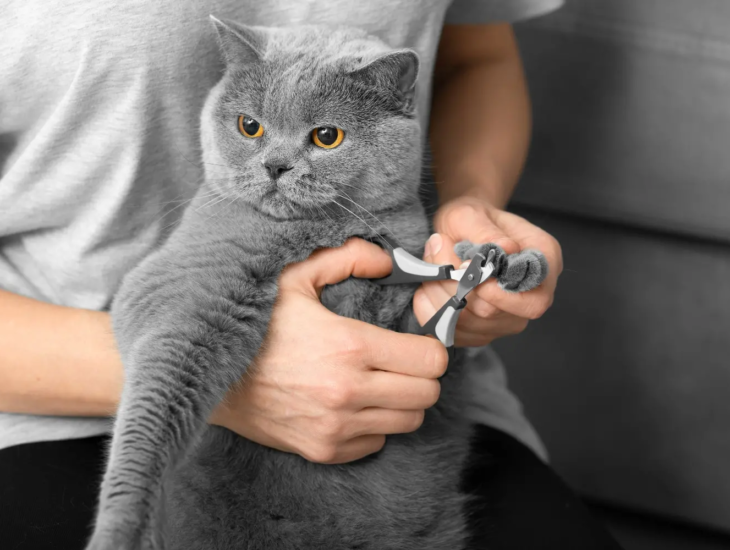Ever watched your cat gracefully scale the curtains, only to cringe at the thought of the damage? Or maybe you’ve felt a sharp prick during a cuddle session?
Keeping those claws in check is essential, not just for your furniture, but for your cat’s well-being too. This article will explore crucial cat claw tips for health and maintenance, ensuring both you and your feline friend live in harmony.
Understanding Your Cat’s Claws
Before diving into maintenance, let’s understand why cats have claws and how they work. They’re not just weapons; they’re vital for climbing, hunting, and even stretching.
The Anatomy of a Cat Claw
A cat’s claw is made of keratin, the same material as our fingernails. Unlike our nails, however, a cat’s claws are retractable.
This means they can be extended or retracted at will. The outer layer of the claw is called the sheath, which sheds periodically.
Why Cats Need Their Claws
Claws are essential for a cat’s physical and mental health. They use them for:
- Grooming: Helping to remove loose fur and debris.
- Climbing: Providing grip and stability.
- Hunting: Catching and holding prey.
- Marking Territory: Leaving scent and visual marks.
- Exercise and Stretching: Keeping muscles toned.
Essential Cat Claw Tips for Health

Maintaining your cat’s claws is crucial for their overall health and comfort. Neglecting claw care can lead to pain, infection, and mobility issues.
Regular Trimming
Trimming your cat’s claws is the most important aspect of claw maintenance. It prevents overgrowth, which can lead to the claws growing into the paw pads.
Use cat-specific clippers, either scissor-style or guillotine-style. Trim only the sharp tips, avoiding the pink quick, which contains blood vessels and nerves.
Recognizing the Quick
The quick is the pink part of the claw that contains blood vessels and nerves. Cutting into the quick is painful and will cause bleeding.
If your cat has light-colored claws, the quick is easy to see. If they have dark claws, trim small amounts at a time to avoid hitting it.
What to Do If You Cut the Quick
Accidents happen. If you accidentally cut the quick, don’t panic.
Apply styptic powder or cornstarch to the bleeding claw to stop the bleeding. Comfort your cat and try again another time.
How Often to Trim
How often you need to trim your cat’s claws depends on their lifestyle and activity level. Indoor cats typically need more frequent trimming than outdoor cats.
A general guideline is to trim every 2-3 weeks. Check your cat’s claws regularly to assess their length.
Introducing Trimming Early
Start trimming your cat’s claws when they are kittens to get them used to the process. Make it a positive experience with treats and praise.
Even if you adopt an older cat, you can still train them to accept claw trimming with patience and positive reinforcement.
Providing Scratching Opportunities
Scratching is a natural and essential behavior for cats. Providing appropriate scratching surfaces can save your furniture and keep your cat happy.
Types of Scratching Posts
There are many types of scratching posts available, including:
- Vertical Posts: Tall posts covered in sisal, carpet, or cardboard.
- Horizontal Scratchers: Flat surfaces made of cardboard or carpet.
- Angled Scratchers: Scratchers that can be placed at an angle.
- Scratching Trees: Multi-level structures with scratching surfaces.
Choosing the Right Scratching Post
Consider your cat’s preferences when choosing a scratching post. Some cats prefer vertical surfaces, while others prefer horizontal ones.
The material of the scratching post is also important. Sisal is a popular choice because it’s durable and satisfying to scratch.
Placement Matters
Place scratching posts in areas where your cat likes to scratch. This might be near their sleeping area, their favorite window, or the furniture they are currently scratching.
You can also use catnip to attract your cat to the scratching post. Reward them with treats and praise when they use it.
Redirecting Scratching Behavior
If your cat is scratching furniture, try redirecting them to a scratching post. Gently move them to the post and encourage them to scratch it.
You can also use deterrents, such as double-sided tape or citrus sprays, to discourage them from scratching the furniture.
Dealing with Ingrown Claws
Ingrown claws are a common problem, especially in older cats. They occur when the claws grow into the paw pads, causing pain and infection.
Recognizing Ingrown Claws
Signs of ingrown claws include:
- Limping
- Excessive licking or chewing at the paws
- Swelling or redness around the claws
- Reluctance to walk or jump
Treatment for Ingrown Claws
If you suspect your cat has an ingrown claw, take them to the veterinarian. The vet can safely remove the ingrown claw and treat any infection.
In some cases, surgery may be necessary to remove the affected claw. Prevent ingrown claws by trimming your cat’s claws regularly.
Preventing Ingrown Claws
Regular trimming is the best way to prevent ingrown claws. As cats age, their claws can become thicker and more brittle, making them more prone to ingrowing.
Pay close attention to your senior cat’s claws and trim them more frequently if necessary.
Diet and Claw Health
A healthy diet is essential for maintaining strong and healthy claws. Nutritional deficiencies can lead to brittle or cracked claws.
The Importance of Protein
Protein is essential for claw growth and repair. Make sure your cat’s food is high in protein.
Look for cat foods that list meat, poultry, or fish as the first ingredient. Avoid foods that are high in fillers, such as corn or wheat.
Essential Nutrients
Other essential nutrients for claw health include:
- Biotin: Supports healthy claw growth.
- Omega-3 Fatty Acids: Reduces inflammation and promotes healthy skin and claws.
- Vitamin E: An antioxidant that protects against claw damage.
Supplements
If your cat has brittle or cracked claws, talk to your veterinarian about supplements. They may recommend a biotin or omega-3 supplement.
Always follow your veterinarian’s instructions when giving your cat supplements.
Recognizing and Addressing Claw Problems
Claw problems can be a sign of underlying health issues. Recognizing these problems early can help you get your cat the treatment they need.
Common Claw Problems
Some common claw problems include:
- Brittle Claws: Can be caused by nutritional deficiencies or dry air.
- Cracked Claws: Can be caused by trauma or infection.
- Claw Infections: Can be caused by bacteria or fungi.
- Claw Tumors: Rare, but can occur.
When to See a Vet
See your veterinarian if you notice any of the following:
- Changes in claw color or shape
- Swelling or redness around the claws
- Bleeding from the claws
- Limping or reluctance to walk
- Excessive licking or chewing at the paws
Diagnosing Claw Problems
Your veterinarian will examine your cat’s claws and may take samples for testing. They may also recommend blood tests to rule out underlying health issues.
Treatment will depend on the underlying cause of the claw problem.
Conclusion
Mastering these cat claw tips for health and maintenance ensures your feline friend stays comfortable and healthy. Regular trimming, providing scratching opportunities, and maintaining a balanced diet are key to preventing claw problems. Keep an eye out for any signs of discomfort or abnormalities, and don’t hesitate to consult your vet when needed.
What are your experiences with cat claw maintenance? Share your tips and stories in the comments below!
FAQ Section
Q1: How do I get my cat used to claw trimming?
A1: Start slowly and make it a positive experience. Introduce the clippers gradually, offering treats and praise. Begin by trimming just one or two claws at a time, and gradually increase the number as your cat becomes more comfortable.
Q2: My cat hates scratching posts. What can I do?
A2: Experiment with different types of scratching posts and materials. Try placing the post in a location where your cat already likes to scratch. Use catnip to attract your cat to the post, and reward them when they use it.
Q3: Is declawing a good option for preventing scratching?
A3: Declawing is a controversial procedure that involves amputating the last bone of each toe. It can lead to chronic pain and behavioral problems. It’s generally recommended to explore alternatives like regular trimming and providing scratching opportunities.










